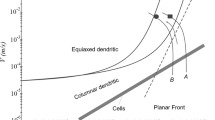Abstract
This study describes the microstructure development as dense tantalum carbide (TaC), which is subjected to extreme temperature environments (3,000 °C) in the presence of oxygen. These are conditions that structural materials are expected to experience in hypersonic aero-propulsion applications. The conditions produce molten oxide which may provide a temporary resistance to rapid oxidation and may go some way to repair thermal shock cracks, however, at the same time the liquid is observed to attack the dense ceramic both chemically and mechanically. A reaction mechanism is suggested which involves dissolution of TaC in the oxide melt and a two step oxidation; first the reaction of TaC with oxygen to form Ta(O,C) and TaO x , resulting in dissolved dissociated carbon, followed by the reaction of dissolved carbon with oxygen to produce gas. This microstructural analysis of one of the candidate ultra-high temperature ceramic materials for hypersonic flight provides new insight into the mechanism of TaC oxidation and the role of the liquid oxide layer in acting not only as a protective layer to further oxidation, as is commonly reported, but also as a dynamic component that promotes erosion of the TaC surface and is a source of further oxygenation of the TaC surface. If the formation of the liquid phase can be better controlled and the reaction of the liquid phase with the matrix be slowed and stabilised, then the formation of a liquid phase at the surface of TaC may provide a key to designing materials that can withstand the rigours of hypersonic flight.






Similar content being viewed by others
References
Wuchina E, Opila E, Opeka M, Fahrenholtz W, Talmy I (2007) Interface 16(4):30
Fahrenholtz WG, Hilmas GE, Chamberlain AL, Zimmermann JW (2004) J Mater Sci 39(19):5951. doi:10.1023/B:JMSC.0000041691.41116.bf
Levine SR, Opila EJ, Halbig MC, Kiser JD, Singh M, Salem JA (2002) J Eur Ceram Soc 22:2757
Carney CM (2009) J Mater Sci 44:5673. doi:10.1007/s10853-009-3799-7
Desmaison-Brut M, Alexandre N, Desmaison J (1997) J Eur Ceram Soc 17:1325
Opila E, Levine S, Lorincz J (2004) J Mater Sci 39:5969. doi:10.1023/B:JMSC.0000041693.32531.d1
Gasch M, Ellerby D, Irby E, Beckman S, Gusman M, Johnson S (2004) J Mater Sci 39:5925. doi:10.1023/B:JMSC.0000041689.90456.af
Wu S, Chan H, Harmer MP (2005) J Am Ceram Soc 88(9):2369
Stephenson N, Roth RS (1971) J Solid State Chem 3:145
Shimada S (2002) Solid State Ion 149(3–4):319
Johnsson M, Shimada S (2002) J Mater Sci Lett 21(12):955
Laurila T, Zeng K, Kivilahi JK (2002) Appl Phys Lett 80(6):938
Garg SP, Venkataramani R, Sundaram CV (1976) J Less Common Metals 50:245
Soukup L, Gregora I, Jastrabik L, Konakova A (1992) Mater Sci Eng B11:355
Shimada S, Johnsson M, Urbonaite S (2004) Thermochim Acta 419:143
Acknowledgements
The authors wish to acknowledge Mr Neil Webb (ANSTO) for carrying out the HIPing of the samples and Prof. Assaad Masri (University of Sydney) for access to the AMME Combustion Laboratory for Hi-TAR testing to be conducted. The authors would also like to acknowledge the financial support of the Defence Materials Technology Centre (DMTC) for the funding and directive of the research contained within this manuscript.
Author information
Authors and Affiliations
Corresponding author
Rights and permissions
About this article
Cite this article
Lashtabeg, A., Smart, M., Riley, D. et al. The effect of extreme temperature in an oxidising atmosphere on dense tantalum carbide (TaC). J Mater Sci 48, 258–264 (2013). https://doi.org/10.1007/s10853-012-6740-4
Received:
Accepted:
Published:
Issue Date:
DOI: https://doi.org/10.1007/s10853-012-6740-4




